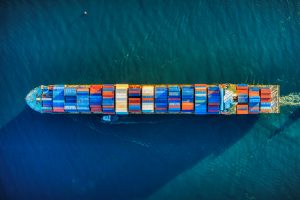
As consumers we rarely think about how the products we order online get to our homes, or how the items we buy from the local shops get there. Indeed, the world is so interconnected nowadays, that buying Japanese tea in a local store in Sweden is nothing out of the ordinary. Neither is ordering a recent technological commodity from China any trouble: it is just a few clicks away and will arrive at your door step in a couple of days. Yet, this seemingly smooth global trade has its vulnerabilities, as recent world events have demonstrated.
First, the COVID-19 pandemic has disrupted global trade. Remember the toilet paper shortage memes in the wake of 2020? Naturally, jokes apart, an unexpectedly high demand for certain products (e.g. oxygen, ventilators, bicycles) paired with disruptions of production lines have created several shortages across many industries. According to some expert opinions, the culprit is the so-called Just In Time (JIT) manufacturing, which is essentially the product of global interconnectedness. In essence, given the relatively quick and easy movement of goods and services around the globe, it makes lots of sense for businesses to reduce inventories and order different supplies on the go, as needed. In other words, why would you stock a product and utilize space for it, if you can order it today and receive it ‘tomorrow’?! The logic makes perfect sense, as long as this global supply chain is not disrupted. Yet, as the recent Suez Canal blockage case demonstrates, sometimes a single ship might be the trigger for a rippling chaos…
In March 2021, the infamous Ever Given cargo ship became another inspiration for countless memes. Again, as amusing as the incident might have seemed at first, the actual implications turned out to be very costly in the literal sense. Given that approximately 12% of global trade and 30% of global container traffic pass through the Suez canal each day, the daily blockage costs were estimated to be around USD $6-10 billion, or the equivalent of $400 million dollars per hour. Naturally these estimated losses are not something many of us can easily relate to… yet, many of us could have felt the ripples. For example, an acquaintance of mine from Estonia experienced the Suez Canal blockage aftermath when the price for installing the pre-ordered roof tiles unexpectedly and dramatically increased. As they were told by the construction company, after the canal blockage incident all construction materials’ prices increased.
As such, on top of the COVID pandemic, the Suez Canal case showcased the fragility and vulnerability of global supply chains, and globalization in general. Indeed, the stuck Ever Given loaded with colourful containers can be seen as a metaphor for creaking globalization, can’t it? Certainly for different anti-globalization types. In a less dramatic view though, we might understand that globalization with its all possibilities and benefits is not something to be ‘rolled back’, yet it can be done better. The recent global trade disruptions may compel businesses to become more aware of the dangers and pitfalls of too much globalization and accelerate needed changes. For example, are there possibilities to shorten supply chains through regionalization? Wouldn’t it be safer to depend on imports from your regional neighbour than a faraway destination? Also, there are sufficient reasons to rethink the JIT manufacturing philosophy by increasing local stocks, hence being prepared for possible future disruptions.
All in all, although globalization means an interconnected world full of possibilities, let’s stay humble, cautious, and smart. Ending on a symbolic note, the ship of globalization is mighty, yet, one imprecise maneuverer is enough to get it stuck…

